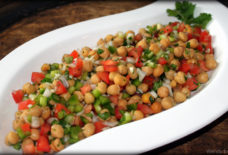In the States
Moroccans make up a relatively small percentage of the American population and gravitate especially to cities like New York, Boston, and Washington DC. There are fine eateries all over, however, from Marrakesh in Portland to Mekki DC in the capital. Kallamni likes Cafe Mogador in the Big Apple, indicating that they put together a quality tagine.
It’s not the easiest food to streamline and place into restaurant form. “Moroccan food isn’t simple,” he says. “Most dishes are low and slow, so it’s not the easiest cuisine for a restaurant to get right.”
If you can’t get out to a proper Moroccan restaurant or don’t have the wherewithal and time to put together a recipe at home, you can try something from Mina and throw it atop some grains, veggies, and protein. The results are quite delicious.
Recipes
Moroccan Fish Stew
Here’s a great fish stew from via Bill Granger and BBC. It comes alive thanks to a pleasant mix of warm spices as well as a subtle kick from ginger and cayenne pepper.
Ingredients
- 1 tbsp olive oil
- 1 large onion, thinly sliced
- 1 garlic clove, crushed
- 2 tsp grated fresh ginger
- 1 tsp ground cumin
- 1 tsp turmeric
- 1 cinnamon stick
- pinch cayenne pepper
- 400g/14oz can chopped plum tomatoes
- pinch salt
- 1 lb 2 oz firm white fish fillets (cod, snapper or ling) cut into chunks
- 14oz can chickpeas, rinsed and drained
- 2 tsp honey
- salt and freshly ground black pepper
Method
- Heat the olive oil in a large heavy-based pan over a medium heat. Add the onion and cook, stirring occasionally, for five minutes, or until the onion is translucent.
- Add the garlic, ginger, cumin, turmeric and cinnamon stick and cook for two minutes, stirring regularly.
- Add the cayenne pepper, tomatoes, salt and 9oz of water and cook, stirring frequently, for ten minutes.
- Add the fish and simmer for five minutes, or until the fish is almost cooked through and tender.
- Add the chickpeas and honey and cook for a further 2-3 minutes, then season, to taste, with salt and freshly ground black pepper.
- To serve, spoon out the tagine into bowls and garnish with fresh coriander leaves and flaked almonds.
Veg Tagine
Jamie Oliver is always reliable when it comes to worldly and healthy cuisine. Here’s a tasty tagine built around flavorful vegetables.
Ingredients
- 1 pinch of saffron
- 4 cloves of garlic
- 1.5-inch piece of ginger
- olive oil
- 1 teaspoon ground cumin
- .5 teaspoon ground cinnamon
- 1 teaspoon ras el hanout
- 1 tablespoon sun-dried tomato paste
- 5.5 lbs mixed vegetables such as aubergines, courgettes, carrots, cherry tomatoes, red onion, butternut squash, and peppers
- 1 can of chickpeas
- 3.5 oz dried apricots
- 1 preserved lemon
- 10.5 oz couscous
- ½ a bunch of mixed fresh herbs , such as dill, mint, flat-leaf parsley (15g)
- 20 g flaked almonds
Method
- Put the saffron into a jug, cover with 2 cups of boiling water and leave to infuse.
- Meanwhile, peel and finely slice the garlic and ginger, then place in a large casserole pan over a medium heat with 2 tablespoons of oil, the cumin, cinnamon and ras el hanout.
- Add the tomato paste, fry for a few minutes, stirring regularly, then pour over the saffron water. Trim and prep the veg, as necessary, then chop into large chunks, adding them to the pan as you go.
- Tip in the chickpeas (juices and all), roughly chop and add the apricots and preserved lemon, discarding any pips, then season with sea salt and black pepper.
- Bring to a boil, cover, reduce the heat to low, and simmer for 45 minutes, or until tender, stirring occasionally.
- When the veggies are almost tender, just cover the couscous with boiling water, season with salt and pepper and pop a plate on top. Leave for 10 minutes, then fluff and fork up.
- Pick the herb leaves and toast the almonds. Serve the tagine and couscous sprinkled with the almonds and herbs. Delicious served with harissa rippled yoghurt.








